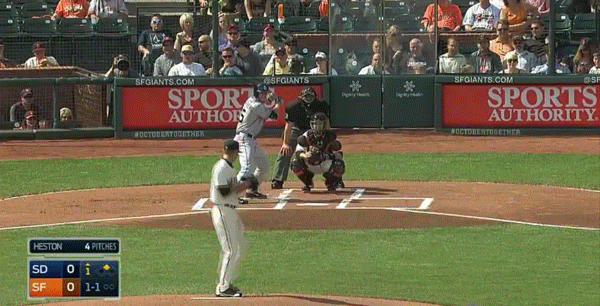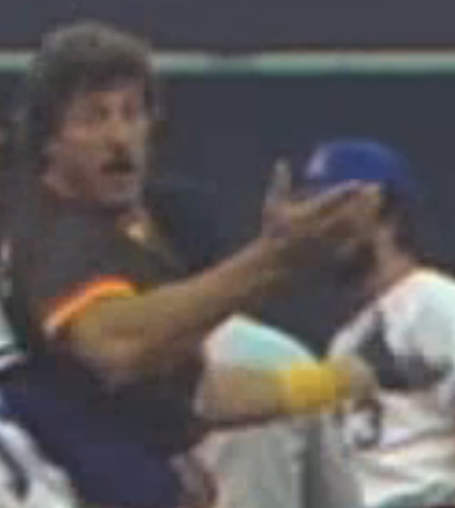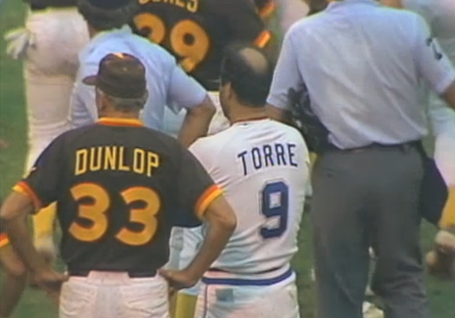![]()
Today I received a much-anticipated parcel; it contained 109 (Buck-O-Nine!) cards, the vast majority of which are of Padres. Since those are the ones you want to see, I'll dive right in.
#1 & 2: 1973 Topps - Vicente Romo and Derrel Thomas
Vicente Romo's 1973 Topps card has a fine example of Topps' atrocious airbrushing during that era. The Derrel Thomas card from that set is not retouched, which is good because it's a great photo with a lot going on. First of course are the uniforms. I also noticed that Thomas opted to go for the seldom-seen look of wearing a batting glove only on his top hand. Most one-glovers wore it on their bottom hand. Additionally, the three players whose numbers are visible wore consecutive digits. While this is a 1973 card, the picture was taken in 1972, so number 31 is not Dave Winfield; it's Rafael Robles. Number 32 that year was Jerry Morales. That won't be the last time you'll see Morales.
#3 & 4: 1975 & '76 Topps - Danny Frisella
I didn't have a Danny Frisella card yet, and I couldn't decide between either of these, so I got them both. I can't get enough of 1975 Topps, and it's also airbrushed which adds a few more kitsch points. By the time the 1976 set came out, Topps had taken a proper photo of Frisella as a Friar. You know how nowadays when there's a throwback game, some players will wear their everyday blue accessories under the brown and yellow? Here's an odd twist on that. It was en vogue during this time for players to wear windbreakers under their jerseys for warmups. Since the Padres had never worn blue to that point, I'm assuming Frisella's windbreaker was a holdover from his days with the Braves; he may have even been holding onto it since his Mets years. It reminds me of Ball Four, when Jim Bouton gets permission from the coaches to practice in his old dark-blue Yankees sweatshirts instead of having to buy a bunch of lighter-blue undershirts. Times have changed.
#5: 1970 Topps - Padres Rookie Stars
See, I said you hadn't seen the last of Jerry Morales. He shares this 1970 Topps card with Jim Williams, who I didn't have a card of before. That was the biggest goal of this order: to snag up cards of Padres I had none of. I knocked about 40 off the list. It seems like I would have completed all the Topps Padres team sets from the 1970s, but I keep seeing ones I didn't have before. I guess it hasn't been a priority and I wouldn't notice anyway since I organize cards by player, not by year or set. I do know that if I did decided to complete the team sets from those years it wouldn't be difficult since I know I do have the team checklists from each season. That brings me to my next set of pickups.
#6-16: Various team checklists and six identical 2006 Upper Deck Robert Fick cards
Topps abandoned the team photo team checklists for quite some while, but brought them back around the turn of the century. I played catch-up with these five. The six Robert Fick cards are for an arts-and-crafts project I have up my sleeve.
#17-19: 1981 Fleer - Willy Montanez, Dennis Kinney, and Mike Armstrong
1981 was the year that Donruss and Fleer showed up on the scene and busted up the Topps monopoly. I really like the basic design on Fleer's inaugural set. I needed a card of each of these guys, so even better that they each had a Padres card in this set.
#20 & 21: 1981 Donruss & 1981 Fleer - Dave Winfield
Donruss and Fleer arrived just in time to capture Dave Winfield as a Padre for the first time, for the last time. Note that Fleer reached way back for that photograph; that jersey was worn only in 1978, plus you can see the patch on his sleeve commemorating the 1978 All-Star Game, which took place at San Diego Stadium.
#22 & 23: 1982 & '83 O-Pee-Chee - Garry Templeton and Juan Eichelberger
O-Pee-Chee was Topps' longtime French-Canadian sister set. Typically their sets were identical to that year's Topps, only with the addition of French to go along with English. Since they were released a bit later, they had a chance to make note of some transactions that Topps didn't. I've always had an affinity for cards that list a player as a member of one team but picture them with another, and both of these are great examples of that.
#24-27: Various Ken Caminiti cards
That Pacific card in the top left is my favorite of these four Cammy cards. I previously had just the Joey Cora and Tony Gwynn from this set. The Dugout Axcess card beneath it is garish and ridiculous, as well as printed on thin cardstock, but it's a good document of the times.
#28 & 29: Ken Caminiti and 2011 Topps Jorge Cantu
No, I didn't foul up and count that Ken Caminiti Headliners card twice. I actually got those other four Caminitis for someone else, but liked this one so much I got one for myself. I ordered the Jorge Cantu card because I didn't have any cards of him yet; about an hour after I ordered these cards, I got an unexpected autographed Jorge Cantu Padres card in the mail.
#30-33: Various Tim Stauffer cards
Like the first four Caminiti cards, this batch of Stauffs is only in my possession temporarily. I already had copies of all of them except his 2006 Topps (top right). I should have picked up two copies of that one, but since I've managed to get by this long without one, I think I'll survive until it occurs to me to pick one up for myself.
#34-38: Various Bud Black cards
Topps is a big fan of recycling images, as you can see on his 2007 flagship and 2007 Allen & Ginter's cards. I really like that Topps Micro card of him with the Blue Jays. A small card for a small tenure. The 1984 Fleer shows his mustache in full glory; he needs to pull a Trebek and bring it back. I was thinking that maybe he could do it as a motivational thing; say, if they win ten games in a row or something, he'll grow it back. Black's 1995 Fleer card in the bottom-right corner is from his second stint in Cleveland. I like 1995 Fleer so much that I got a copy of this one for myself, too.
#39-41: Three copies of Lance McCullers' 1988 Topps card
Alright, back to cards I got for myself. For those who don't know, my main collection is Joey Cora cards. I'm out to acquire as many copies of all of his cards. Just Commons had exactly zero Joey Cora cards, because I bought all of the ones they had on my last order, so I cleared them out of cards he cameos on. Several months ago, I mentioned something about Cora being in the background of that Lance McCullers card, and promptly forgot about it. You know who didn't forget about it? Jodes. A couple of weeks ago, she sent me a copy of it, amongst many other things. So, thanks a million for the reminder, along with everything else.
#42 & 43: 2014 Bowman - Jordan Paroubeck and Hunter Renfroe
How bad is that Photoshopping on Jordan Paroubeck's 2014 Bowman card? There's no outline around the unrealistically stretched lettering, and note the lack of "headspoon" piping. Hunter Renfroe's card from the same set is also sloppily 'shopped, but at least they remembered the headspoon.
#44 & 45: 2014 Topps Pro Debut - Travis Jankowski and 2011 Topps Heritage Minors - Jaff Decker
Decker isn't in the organization anymore, and hasn't been for a year, but I still needed a card of him. I chose this Topps Heritage Minors card for multiple reasons; it's a good picture, I don't have many San Antonio Missions cards, and I love the 1962 Topps design. The 2014 Topps design is okay, I guess, but my main takeaway is that Travis Jankowski needs to work on #gains.
#46 & 47: 1992 Classic Best - Sean Mulligan & 1971 Topps - Tommy Dean
No Padres cards exist of two-game wonder Sean Mulligan, so this minor league card will have to work as a place-filler. The 1971 Topps Tommy Dean card is well-worn, but I think I like it better that way. It has character and stories I'll never know; plus, it helps that cards aren't investments to me.
#48: 1982 Topps - Padres Future Stars
Topps' split rookie cards have always been a good source of guys who didn't get many, or even any, cards of their own. This is my first card of Fred Kuhaulua; a brief search suggests it's the only one of him as a Friar. It would have been my first Mike Armstrong card as well, but I also got that 1981 Fleer of him. As for Doug Gwosdz, I have a couple other cards of "Eyechart".
#49 & 50: Kevin Jarvis Brown
When they arrived, these cards of Kevin Jarvis and Jarvis Brown were back-to-back. Well, back-to-front, technically. The point is that they were one-after-the-other, and it was perfect.
#51-53: Early-2000s short-termers
I was glad to find a Roger Deago card, since he's a two-game wonder. The understated Fleer Tradition design isn't half-bad, either. It seemed like I would have already had a Bret Boone card because he was a semi-star in the heart of the overproduction era, but this is my icebreaker. As you might imagine, there were far more Bret Boone cards to choose from than ones of Domingo Guzman.
#54 & 55: 2003 Topps - Gary Bennett and 1997 Donruss - Trey Beamon
I got these just to have one of each guy, but it turned out that I already had a card of Gary Bennett with the Padres. Oh, well. It won't hurt to have another. Beamon was a member of the Padres during the down-year of 1997. He appeared in a career-high 43 games, sandwiched between his debut season with the Pirates and his sunset season with the Tigers.
#56-63: Topps Total, 2002-'05
Topps Total was great. As the name implied, it included a lot of players that got overlooked in other sets. That made it the go-to set for relievers and fringy non-prospects. I'm glad to finally have a Rod Beck from his Padres days, even though it features a fairly awkward photo, presumably of him flipping the ball to first base. Also, how great is that bat-barrel shot of Mark Sweeney?
#64 & 65: 2001 Topps Chrome - Alex Arias and 1993 Fleer Update - Mark Ettles
As you might have suspected, I got these because I didn't have any of either player. I wish I had selected any other card of him, because this one has a bad case of "Chrome curl" In older Topps Chrome cards, they warp outward over time, and it makes them a pain to store. The Ettles card is nice and flat though, so that's nice.
#66-68: 2006 Upper Deck - Dewon Brazelton, Alan Embree, and Vinny Castilla
I used to have copies of all three of these cards, but they somehow fell off the face of the earth. I needed a Dewon Brazelton card; the fact that this one has a sweet bunting shot is just a bonus.
#69-72: Topps, 2007-2009 - Jose Cruz, Michael Barrett, Chip Ambres, and Chris Burke
This 2008 Topps Chip Ambres card is also one I used to have, but the others are new-new to me. I liked Jose Cruz while he was briefly with the Padres in 2007, and have a Michael Barrett road jersey, so it's about time I got Padres cards of them. I don't have any reason to be particularly excited about the Chris Burke card, other than that he's one less Padre I don't have a card of.
#73 & 74: 2008 Topps '52 - Jack Cassel and 2014 Topps Tyson Ross
This seems like an unusual pairing, but I didn't have Padres cards of either of these guys. It's kind of embarrassing that I hadn't gotten around to picking up a card of Tyson Ross, but I do have a couple of cards from his A's tenure if that helps. Jack Cassel didn't have the success of Tyson Ross, but both of them have brothers who throw things for a living. Jack's brother is injured Vikings quarterback Matt Cassel, formerly of the Patriots and Chiefs; Tyson's brother Joe Ross is a minor league pitcher in the Padres organization.
#75: Tim Stauffer 2005 Bowman Game-worn Futures Game USA jersey
I probably should have grouped this with the other Tim Stauffer cards, but it seemed worth saving until the end. One thing I don't like about some game-worn jersey relic cards is when the player is pictured wearing a jersey that doesn't match the swatch. That isn't the case here, as the jersey is the one from that particular one-time-only event.
It wasn't the flashiest or priciest bunch of cards, but I feel like I got the most bang for my buck and covered all the bases I had in mind, and some I didn't.






















